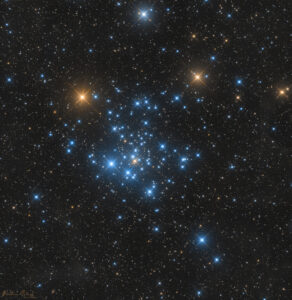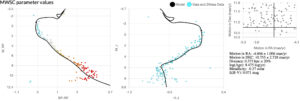Many star clusters observable with the naked eye rest in the sky today. One such open cluster idling south of the celestial equator is NGC 2516. The young age cluster NGC 2516 can be found within the Southern Hemisphere’s Carina constellation. Originally discovered by the 1751 French astronomer Nicolas-Louis de Lacaille while on the African Cape of Good Hope, it was eventually nick-named The Southern Beehive for its similarly structured scattering of stars to the Beehive Cluster of the northern hemisphere. Its apparent brightness of 3.8 mag allows astronomers and enthusiasts alike to observe it.

Although it was discovered in the 18th century, the young star cluster still maintains its mystery. A recent study by Bouma et al (2021) made comparisons in age to the denser core of the NGC 2516 star cluster and its more outer halo. They determined from comparing rotational periods that both areas appear to have the same relative age of 150 Myr despite the outer halo having a larger population of stars. As well, an older study by Damiani et al (2003) found within the main sequence stars there were several low-X ray B stars that released X-ray emissions and some A type stars that exhibited Ap traits such as an overabundance of metals.
In order to analyze the NGC 2516 star cluster and its intersections of color, brightness, chemical composition, and age I captured 15 images using Skynet with the aid of the PROMPT5 telescope at the Cerro Tololo Inter-American Observatory. I took 5 images with each color filter: B (blue), V (green), and R (red). For the filters, I set the exposure duration to 7.32 seconds for B and 4.88 seconds for both V and R. In Afterglow, I combined the B, V, and R images and processed the initial unreddened image. From the later values gathered from Cluster Pro Plus, I was able to de-redden the image by adjusting the E(B-V) value:


Also, I was able to create a batch photometry of the stars usable to the Cluster Pro Plus. From the Cluster Pro Plus, I was able to determine NGC 2516’s probable distance, age, metallicity, and interstellar reddening as well as several other values after filtering out the field stars and fitting the data to an Isochrone Model.

Several values determined from Cluster Pro Plus are listed in the chart below:
| Motion in RA (mas/yr) | Motion in DEC (mas/yr) | Distance (kpc) | log(Age) (log(yr)) | Metallicity (solar) | E(B-V) Extinction (mag) |
| -4.604 ± 1.006 | 10.755 ± 2.728 | 0.47 ± 20% | 8.18 | -0.53 | 0.12 |
The graph reveals a typical young open cluster with a main sequence (ie, they fuse hydrogen in their core). In the case of NGC 2516, its close location presented a slight difficulty in analyzing the data. Because of its proximity, more of the main sequence, specifically in the lower right region, exhibited scatter. As well, fewer stars were available in the image because of that same closeness and the telescope’s field of view. Due to the star cluster’s brightness and the fact the telescope’s field of view was only able to capture part of the NGC 2516 cluster, it appears like data parameters plotted from Kharchenko et al (2013) provide a closer approximation of its values.

Several values taken from these data parameters are listed in the chart below:
| Motion in RA (mas/yr) | Motion in DEC (mas/yr) | Distance (kpc) | log(Age) (log(yr)) | Metallicity (solar) | E(B-V) Extinction (mag) |
| -4.604 ± 1.006 | 10.755 ± 2.728 | 0.373 ± 20% | 8.475 | -0.37 | 0.071 |
In a comparison with my collected data and the MWSC parameter values from Kharchenko et al, it appears that while the MWSC values are slightly more reliable, no significant differences appear. For instance, the MWSC graph appears to have a tighter isochrone fit to the data points with a higher metallicity congruent with an open cluster. The isochrone model determines the overall properties of the cluster, so a tighter fit represents a higher chance of accurate conclusions. My data indicated a log age of 8.18 while the MWSC found the age to be slightly older at 8.475. As well, the turn-off point, the point used to determine a cluster’s age, is more defined. However, the MWSC parameters do not significantly change the initial values, and I believe both indicate a typical young open star cluster.
The NGC 2516 open cluster allowed me to explore the mechanics of batch photometry and analyzing the age of stars with Cluster Pro Plus. The process of assembling a color image of a star cluster and dereddening it gave me a new appreciation for available stellar images.